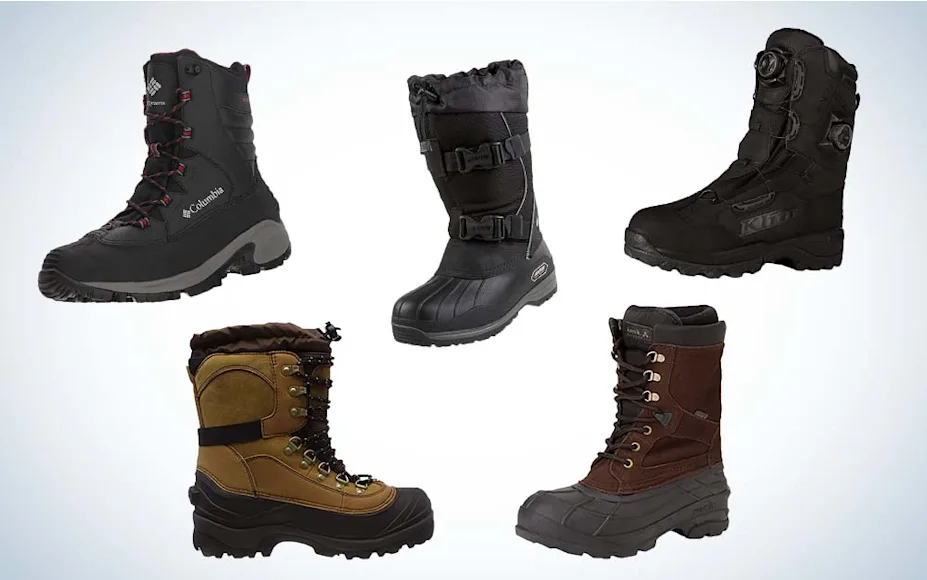_We may earn revenue from the products available on this page and participate in affiliate programs. Learn more ›
_
Best Overall
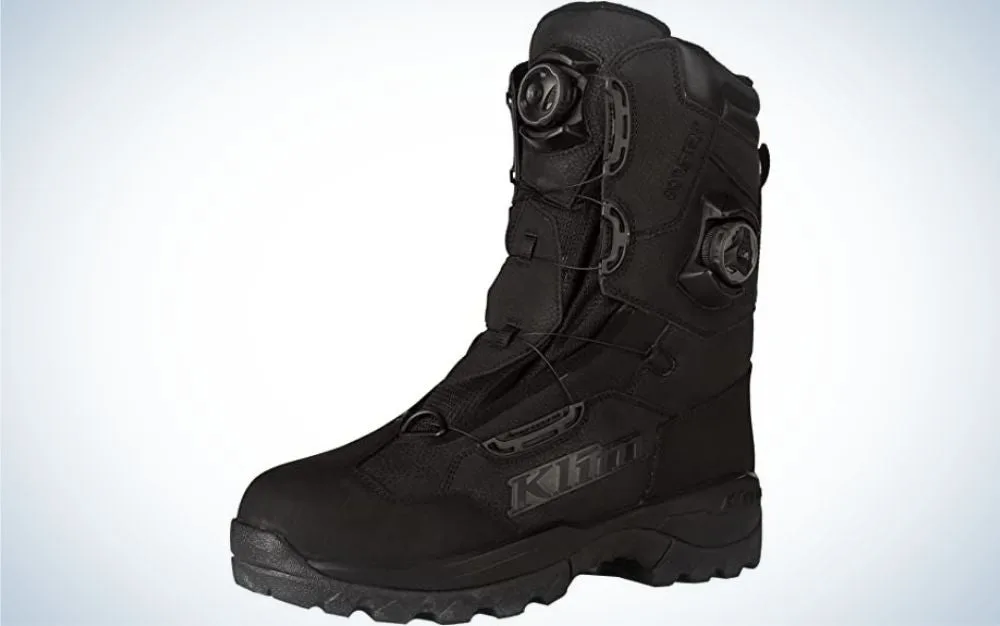
KLIM Adrenaline Pro GTX BOA Winter Waterproof Boots
LEARN MORE
Summary
This is a tough, supportive, warm, and comfortable boot designed for riders who like to push the limits in all conditions.
Best for Women

Baffin Impact Women’s Snowmobile Boot
LEARN MORE
Summary
Constructed specifically for the female foot, this boot has a removable, multi-layer interior that will keep the rider warm in truly extreme temperatures.
Best Budget
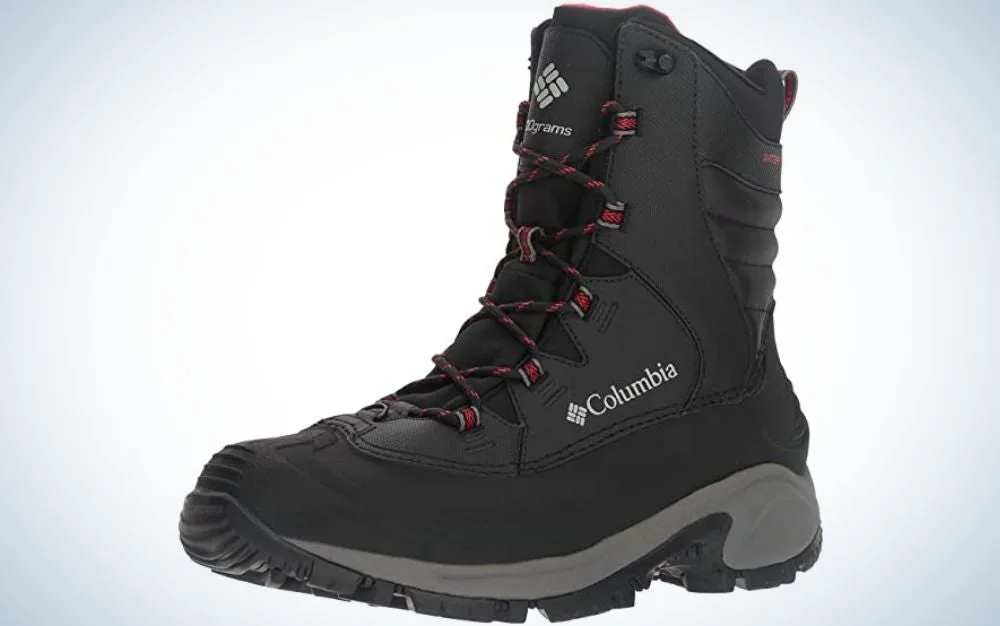
Columbia Men’s Bugaboot III Snow Boot
LEARN MORE
Summary
Here’s a lightweight yet durable boot that offers excellent performance in the snow, and looks good enough for casual wear.
A good pair of snowmobile boots are crucial for good riding. Warmth is a key factor, but not just for comfort—it also impacts safety. On a snowmobile there’s not just the normal cold of being out in the snow, there’s also wind chill to consider. Even at relatively modest speeds, the temperature you are subject to drops dramatically. According to the National Weather Service wind chill chart, if it’s 30°F outside, and you’re riding at 30mph, you are actually subject to 15°F. If the temperature drops to 0°F, the wind hits you at -26°F.
Inadequate protection puts you at serious risk of frostbite. Cold also drains your energy so it’s easy to lose concentration, and you’re more likely to have an accident. Along with other cold weather gear like the best snow pants
, the best snowmobile boots are designed to provide warmth, comfort, and physical protection.
Best Overall: KLIM Adrenaline Pro GTX BOA Winter Waterproof Boots
Best for Women: Baffin Impact Women’s Snowmobile Boot
Best Budget: Columbia Men’s Bugaboot III Snow Boot
Best for Cold Weather: Sorel Men’s Conquest Winter Boot
Best for Wide Feet: Kamik Men’s Nationplus Boot
Things to Consider Before Buying Snowmobile Boots
Modern snowmobile boots come in a variety of materials and configurations. While it’s great to have plenty of choice, the jargon can sometimes be confusing. Knowing the technical aspects will help you pick the best pair of boots for you.
Insulation
Thinsulate is perhaps the best-known brand of insulation, made by 3M. It’s lightweight and thin, so it doesn’t add a lot of bulk to the boot. Thinsulate is rated in grams (g) and the amount typically varies from 200g to 1000g. Thermolite is a similar material, and some boot makers use their own versions of insulation.
Multi-layer insulation tends to be bulkier, but often includes a moisture-wicking layer for sweat management if the feet do get hot, and padding for comfort. Reflective insulation like Omni-Heat (developed by the Columbia brand) is another popular option.
For simplicity, many manufacturers give an actual comfort rating in degrees Fahrenheit (°F). Insulation in the form of removable liners allow you to air it, or dry it out if it should get wet.
Waterproofing
There’s a common misunderstanding that insulation and waterproofing are the same things. In many cases they are not. Also, natural materials like leather and suede are water-resistant, but not fully waterproof, though these can be treated with pastes or sprays that increase water resistance.
Sometimes boots are treated with a PU (polyurethane) coating
. Other snowmobile boots use a nylon or rubber shell. An internal waterproof/breathable membrane is another option. GoreTex is the leading brand, but there are several others.
Traction
The soles of snowmobile boots are usually synthetic rubber or polymer so the treads remain flexible, and therefore provide good grip even in extreme cold. Tread patterns are aggressive with deep lugs that provide sure-footed traction through snow, and on icy surfaces.
Physical Protection
Most snowmobile boots have what is called a kick plate at the front of the boot. This is usually formed by extending the sole material up and over the toe area. Other impact plates may be added, typically around the ankle area.
Closures
Although laces are common, they are awkward to use with gloved hands, and can freeze up, making them a nuisance to undo. Some of the best snowmobile boots use BOA closures, which are flexible stainless steel wires that open and close via knobs on the front and/or side. They are easy to use, very strong, and secure. Some other boots use a combination of quick-release plastic buckles, and pull cords. These are also very straightforward, though not as durable as BOAs.
Best Overall: KLIM Adrenaline Pro GTX BOA Winter Waterproof Boots
Best Overall

Why It Made The Cut: The KLIM Adrenaline Pro GTX BOA is a high-performance snowmobile boot primarily aimed at those that relish the challenge of fast riding in harsh conditions.
Key Features
Material: Leather and nylon
Size Range: 4 to 15
Cold Rating: -40°F
Pros
Strong construction using high-quality materials
Thinsulate and GoreTex interior
BOA closure
Cons
Expensive
Stiff sole
The KLIM Adrenaline Pro GTX is our choice for best snowmobile boot overall. It is also the top pick of many other independent reviewers. It is tough, warm, dry, and comfortable over long riding periods.
The upper is mostly leather, which is very durable and gives good protection. It uses a dual-zone BOA for closure, one part over the foot area, the other over the shin. This provides a very good seal around the tongue, and ensures a snug fit. Inside is a waterproof/breathable GoreTex membrane, plus 600g of Thinsulate for warmth that is rated down to -40°F. A high-comfort liner has moisture wicking to help prevent sweat pockets that can cause blisters.
The cushioned insole comes from foot care specialists Ortholite. It is also moisture wicking and can be removed for airing, or can be swapped out if you want to insert a custom insole. The outsole has a very aggressive tread pattern designed to maximize grip in snow and ice, and give excellent durability.
Even with the ankle cutout that allows the boot to flex, it is a little stiff. The KLIM Adrenaline Pro GTX is great for snowmobile riding, but it is not a boot for walking any great distance.
Best for Women: Baffin Impact Women’s Snowmobile Boot
Best for Women

Why It Made The Cut: The main feature of the Baffin Impact Snowmobile Boot is its protection from extreme cold. According to the manufacturer it has been tested at both North and South Poles.
Key Features
Material: Leather, nylon and rubber
Size Range: 6 to 11
Cold Rating: -148°F
Pros
Can withstand extreme cold
Drawstring snow collar
Snowshoe compatible
Cons
Bulky
Not all of the upper is waterproof
Some women’s snowmobile boots are simply men’s boots made in smaller sizes. However, the female foot shape is different to the male, so this is a compromise that can lead to poor fit, and discomfort. Although a men’s version is available, the Baffin Impact women’s snowmobile boot is constructed specifically for women.
Three sections comprise the upper. At the bottom is a durable, waterproof, composite rubber shell. Stitched to that is an abrasion-resistant leather section that allows the foot to flex. Above that is hard-wearing nylon, which reduces weight. While this top section is water-resistant, it is not fully waterproof, and so is not appropriate for wading. Two buckles allow for quick fastening, and a drawstring top seals out the cold.
The multi-layered interior offers tremendous warmth and comfort. Diamond Net insulation prevents wind getting through to the foot. The Thermaplush liner is soft, moisture-wicking, and breathable. Hollow fibers trap heat, and are combined with aluminum that reflects the body’s warmth. The insole also has aluminum for heat retention, and “waffle comb” cushioning. The entire liner can be removed for airing or drying, if necessary. The rugged outer sole has sharp lugs designed to offer maximum traction in all conditions.
All that insulation does make for bulky boots, and they do come with a premium price tag, but if your priority is keeping your feet warm while riding in the coldest conditions, nothing beats a pair of Baffin Impact boots.
Best Budget: Columbia Men’s Bugaboot III Snow Boot
Best Budget

Why It Made The Cut: The Columbia Men’s Bugaboot III Snow Boot is lightweight and offers better mobility than many snowmobile boots. It has good insulation, is fully waterproof, and competitively priced.
Key Features
Material: Leather and rubber
Size Range: 7 to 17 (including wide sizes)
Cold Rating: -25°F
Pros
Warm and fully waterproof
Light enough for hiking
Excellent value
Cons
Not for severe cold
May run a little small
The Columbia Men’s Bugaboot III Snow Boot is the kind of general-purpose, cold weather footwear that can be worn while snowmobile riding, or hiking through the woods, but doesn’t look out of place in an urban environment.
As is common with snow boots, the upper is in two sections. An injection-molded rubber shell provides the first layer of protection from the cold, and above that is hard-wearing leather that is PU (polyurethane) coated for waterproofing. Seams are also sealed so water can’t get in, and a padded collar closes securely at the top. The Columbia Bugaboot is quite tall for a hiking-style winter boot, providing protection well up the leg.
The boot has 200g of insulation, with an Omni-Heat reflective liner that keeps the warmth in. There’s a faux fur lining for comfort, a removable insole, and an EVA foam midsole for cushioning. The Omni-Grip sole uses two types of rubber to maximize traction in different conditions. The sole is also non-marking.
The Columbia Men’s Bugaboot III Snow Boot is affordably priced, and very popular. A minority of wearers think they run a little small, and are narrow at the toe.
Best for Cold Weather: Sorel Men’s Conquest Winter Boot
Best for Cold Weather
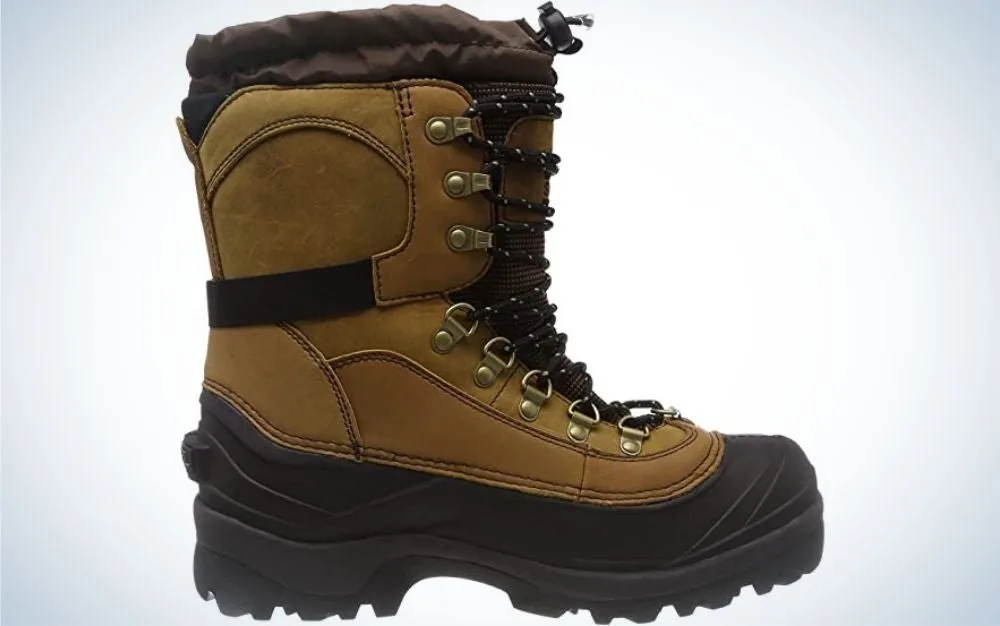
Why It Made The Cut: The Sorel Men’s Conquest Winter Boot is an all-purpose model with excellent all-terrain traction that is equally at home snowmobile riding, hunting, trekking, or ice fishing.
Key Features
Material: Leather, synthetic fabric and rubber
Size Range: 8 to 14
Cold Rating: -40°F
Pros
Excellent all-surface performance
Gaiter bootie seals out snow
High-traction cleat design
Cons
Slow to get on and off
Lace quality could be improved
The Sorel Men’s Conquest is our top pick as the best cold weather boot. That’s not just because of its -40°F comfort rating, but also because it can tackle a wide variety of conditions—mud, ice, and thick snow.
The upper consists of an injection-molded rubber shell bonded to leather, and synthetic fabric. The latter is polyurethane coated to keep out wind and water. Seams are also sealed. A gaiter closure with barrel lock keeps snow out of the top. Although the lacing system makes it slow to get the Sorel Men’s Conquest on and off (and the original laces are not very durable), it does provide a secure and comfortable fit. There’s also an Achilles adjustment strap for ankle support, which can help prevent injury in treacherous conditions.
Insulation is 400g Thinsulate Ultra, which provides high performance with minimal weight. The felt inner and cushioned EVA footbed both add comfort, and can be removed if necessary.
Although the Sorel Men’s Conquest winter boot looks bulky, it’s actually surprisingly light, flexible and maneuverable. Multi-directional lugs on the composite rubber sole offer high traction without drag.
Best for Wide Feet: Kamik Men’s Nationplus Boot
Best for Wide Feet
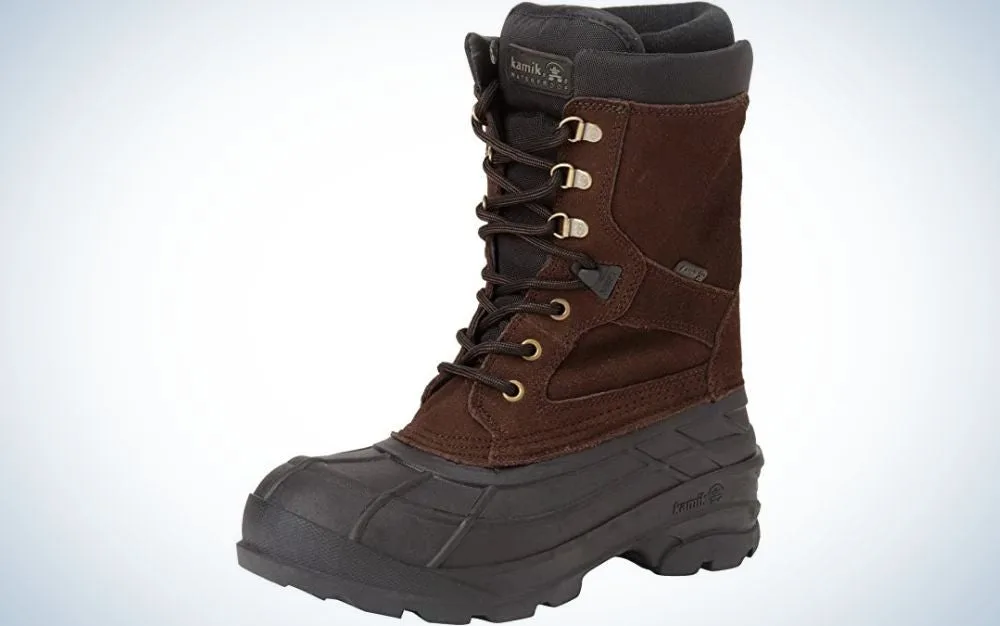
Why It Made The Cut: The Kamik Men’s Nationplus Boot is constructed to offer what the manufacturer calls a “more generous fit” so those with wide feet get the comfort and warmth they need.
Key Features
Material: Leather and rubber
Size Range: 7 to 14 (including wide sizes)
Cold Rating: -40°F
Pros
Light and flexible
Numerous color options
Affordable
Cons
Slow to put on and take off
Not as protective as some other boots
Snowmobile riders with wide feet might struggle to find boots that are comfortable. The Kamik Men’s Nationplus Boot is made in wide fittings and comes with both 1/2 sizes, and wide fittings so everyone should be able to find the correct size.
Construction is typical of many snowmobile boots with a rubber shell and a durable suede leather upper, with a sealed seam. The boot is quite flexible, and provides good freedom of movement. It is also comparatively light. The tradeoff is that the leather isn’t as supportive as some rivals. A tall shaft does provide protection well up the leg, though lacing and unlacing is a little slow. There is a padded gaiter at the top.
Older models of the Kamik Men’s Nationplus used 200g Thinsulate, but the boot now has the brand’s own Heat-MX sustainable insulation, providing warmth down to -40°F. The moisture-wicking liner is removable for airing. The insole is very basic, so buyers may want to consider an orthotic insert. The boots aren’t uncomfortable, but this is one area where they could be improved.
The sole is molded as part of the shell, so there is no seam to leak. The Snowtread synthetic rubber has self-cleaning lugs that provide excellent traction in both snow and mud. The Kamik Men’s Nationplus is also very competitively priced.
How I Made My Picks
I’ve ridden snowmobiles, so I know the type of footwear that’s required. I also know that riding conditions and needs vary, so there’s no one best snowmobile boot. I extensively researched all the leading snowmobile boot manufacturers, their current lineups, and the construction and materials used in each model and compared them all.
Price was also a factor. It’s not difficult to find cheap boots for snowmobile use, but they often lack durability, may not be as warm or comfortable as advertised, and typically are a poor investment. That said, while all of my final recommendations are from highly regarded brands, several of the boots I chose are competitively priced, and offer excellent value.
FAQs
Q: How much do snowmobile boots cost?
High-quality snowmobile boots usually cost somewhere between $80 and $400 per pair. Don’t get cheap boots, as they seldom handle the conditions for long, and often turn out to be poor value as a result.
Q: How do I keep my feet warm while snowmobiling?
The best way to keep your feet warm while snowmobiling is to buy a pair of snowmobile-specific boots, which are designed to withstand the specific conditions snowmobilers encounter. Make sure they fit well and aren’t too tight, which will inhibit circulation and make your feet cold. Also wear a good pair of winter socks[1] .
Q: What does the temperature rating mean?
The temperature rating for snowmobile boots (and other cold weather boots) is the minimum temperature at which your feet will remain comfortably warm. Ratings can vary considerably, and it’s important that you have boots suitable for the conditions you will be facing.
Q: Can I wear snowboard or ski boots for snowmobiling?
You could wear snowboard or ski boots for snowmobiling, but it isn’t recommended. Those boot types are intended for a different conditions, and won’t perform to the same standard as snowmobile boots.
Q: Are snowmobile boots worth it?
The best snowmobile boots are worth it if you ride regularly, because they combine warmth and flexibility.
Q: Are snowmobile boots true to size?
Whether snowmobile boots are true to size will depend on the manufacturer. Some assume you will add thick socks, and allow extra room accordingly. Others do not. It is worth checking maker recommendations, and owner feedback, before deciding.
Final Thoughts
With the Adrenaline Pro GTX BOA Boot
, KLIM offers the ultimate snowmobile boot for sports riders, and adventure junkies. It consistently tops independent reviews, and excels in just about every area. However, regardless of how good it is some people will balk at the high price.
At the other end of the cost spectrum is the Columbia Bugaboot III Snow Boot
. While it may not have all the fancy technology it is a durable, comfortable, safe, and warm alternative for those who are riding in cold, but not extreme conditions.
Reference if required: https://www.weather.gov/safety/cold-wind-chill-chart

